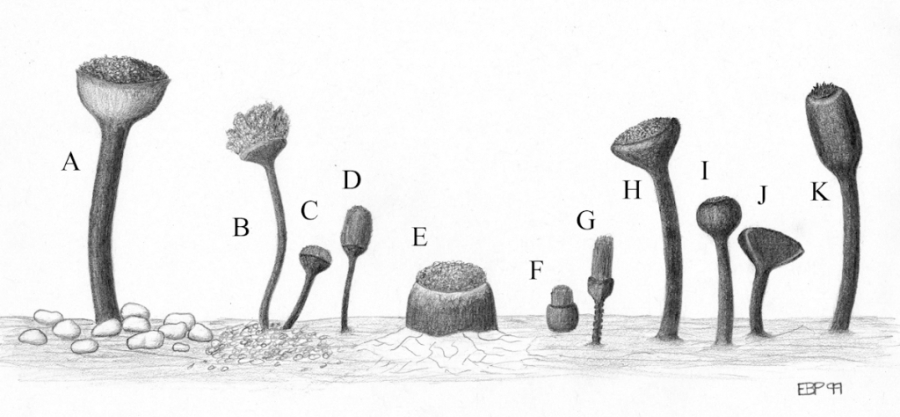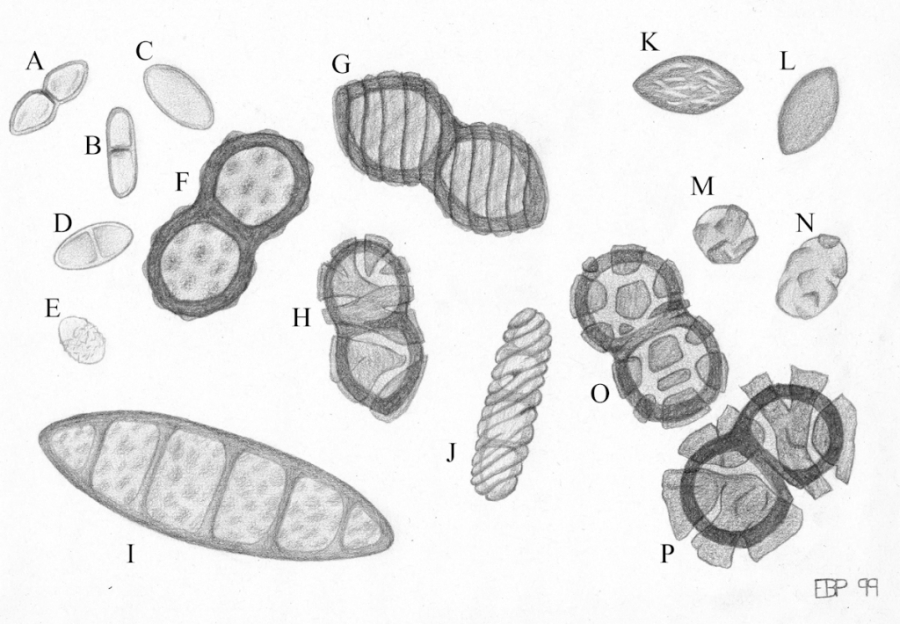Subsections:
<- Return to Table of Contents and Introduction
This section last updated: 2013-04-26
Conceptual Illustrations
Figure 1. Conceptual illustration of common temperate calicioid genera. (A) Calicium, (B) Chaenotheca, (C) Chaenthecopsis parasitic on Chaenotheca, (D) Chaenothecopsis saprophyte, (E) Cyphelium, (F) Microcalicium sessile form, (G) Microcalicium stalked form, (H) Mycocalicium, (I) Phaeocalicium, (J) Phaeocalicium with flattened capitulum, (K) a large Stenocybe such as S. clavata (most are shorter relative to other genera). Not illustrated: Acroscyphus, Texosporium, and Thelomma resemble Cyphelium (E) but except for Texosporium, with generally greater thallus development; Brucea resembles Chaenothecopsis (D) but with a brownish capitulum; “Cryptocalicium” resembles a small Chaenothecopsis (D) or Microcalicium (G) except that it is buried within white hyalin hairs and thus not clearly discernable; Sclerophora resembles Chaenotheca (B); Sphinctrina somewhat resembles Phaeocalicium (I) but usually with a shorter stouter stalk and more constricted excipulum, Tholurna resembles Calicium except with a much broader, pale stalk. Of course, most genera include exceptions to these concepts.
Figure 2. Conceptual illustration of variation among calicioid spores. (A-E) typical of Chaenothecopsis, (F-H) typical of Calicium, (I) typical of Stenocybe (J) typical of Microcalicium, (K-L) typical of Mycocalicium, (M-N) typical of Chaenotheca, (O-P) typical of Cyphelium. Of course, most genera include exceptions to these concepts.
Key to Genera
1a. Ascomata with a distinct stalk…
2a. Spore mass brown, orange, or pale and sometimes yellowish…
3a. Spore mass orange, stalk and excipulum with hyaline hairs, up to 0.3 mm tall, with a greenish reaction in KOH: “Cryptocalicium” new?
3b. Spore mass brown or pale and sometimes yellowish
4a. Saprophytic on resin, non-lichenized: Brucae castoris
4b. Lichenized…
5a. Spore mass distinctly brown: Chaenotheca
5b. Spore mass distinctly pale, often with white or yellow pruina: Sclerophora
2b. Spore mass black or dark greenish, sometimes dusted with pruina…
6a. Ascomata with thaline “stalks”, often thicker than the capitulum (head), white to gray, containing algae, up to 1 cm tall: Tholurna dissimilis
6b. Ascomata with true stalks, narrower than the capitulum, not very thick, generally shorter, and typically black or nearly so…
7a. Forming a true mazaedium of loose spores from the premature disintegration of asci…
8a. Spore mass with a peculiar greenish color, spores narrow with parallel sides, abruptly rounded, with a strong spiral ornamentation (Fig. 2 J): Microcalicium
8b. Spore mass without a peculiar greenish color, or if so, then spore sides not parallel…
9a. Excipulum with a tightly constricted margin, spores non-septate or if septate then with a thin wall and lacking clear ornamentation: Sphinctrina
9b. Excipulum generally not with a tightly constricted margin, spores always septate and with a thick wall that usually shows distinct ornamentation at maturity (Fig. 2 F-H): Calicium
7b. Non-mazaediate (spores remaining in the asci until mature, or nearly so)…
10a. Spores more or less pale as seen in a compound microscope, even when mature; spores 0-1 septate (Fig 2 A-E); on aged substrates: Chaenothecopsis
10b. Mature spores strongly pigmented, especially at maturity; spores 0-many septate; on either aged substrates or young bark of twigs (Fig 2 I, K, L, or intermediate)…
11a. Spores non-septate (Fig 2 K, L)…
12a. Ascus tip lacking an apical canal. (This is often visible without stain, but a cytoplasmic stain such as cotton blue can make it more obvious. Often it will appear as though the tip of the ascus has a small square void between the last spore and the solid apex): Mycocalicium
12b. Ascus tip with an apical canal: Chaenothecopsis
11b. Spores septate (Fig 2 I and variations toward A-C)…
13a. Spores regularly multiseptate and capitulum never flattened (though some with numerous flattenings resulting in a +/- pentagonal shape – note weak flattening in Fig 1K): Stenocybe
[The distinction between these two genera is weak and keys by Titov blend them as though they are a single genus; however I maintain the distinction here pending a better circumscription.]
13b. Spores primarily 1-septate (some species with a minority of spores becoming multiseptate); capitulum strongly flattened (Fig 1 J) or not (Fig 1 I): Phaeocalicium
1b. Ascomata sessile to immersed (Fig 1 E and F)…
14. Spore mass with a peculiar greenish color…
15a. On bark or wood: Microcalicium
15b. On soil: Texosporium sancti-jacobii
14b. Spore mass otherwise…
16a. Rim of excipulum tightly constricted: Sphinctrina
16b. Rim of excipulum not tightly constricted…
17a. Thallus dactyliform, with a yellow to orange medulla:
Acroscyphus sphaerophoroides
17b. Thallus crustose, medulla not yellow to orange…
18a. Rim of ascomata (excipulum) clearly visible above the thallus surface: Cyphelium
18b. Ascomata (excipulum) sunken deeply into the thallus such that the rim does not rise above the surface…
19a. Thallus intensely yellow: Cyphelium
19b. Thallus not intensely yellow: Thelomma

